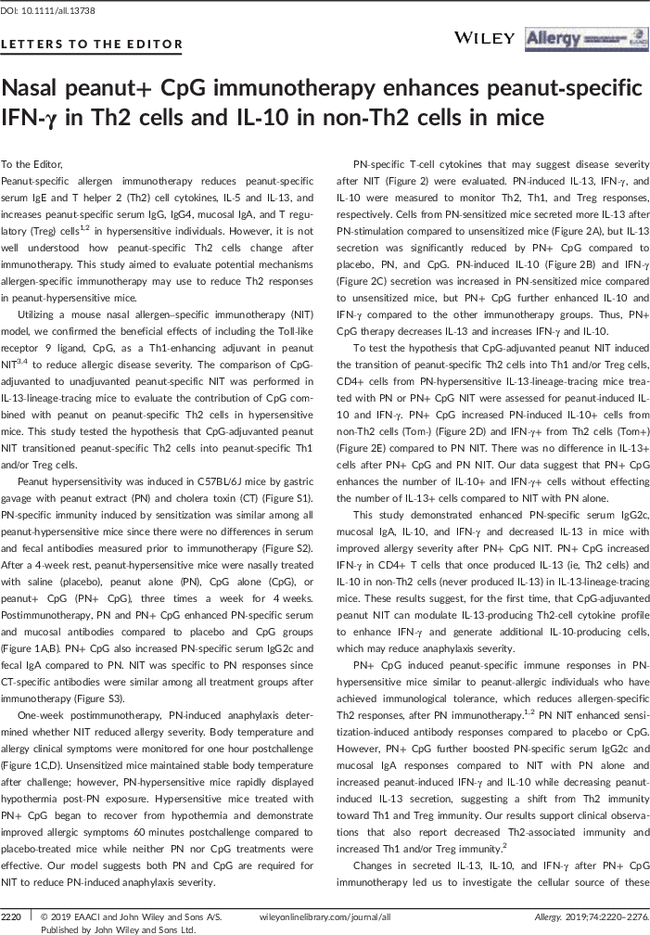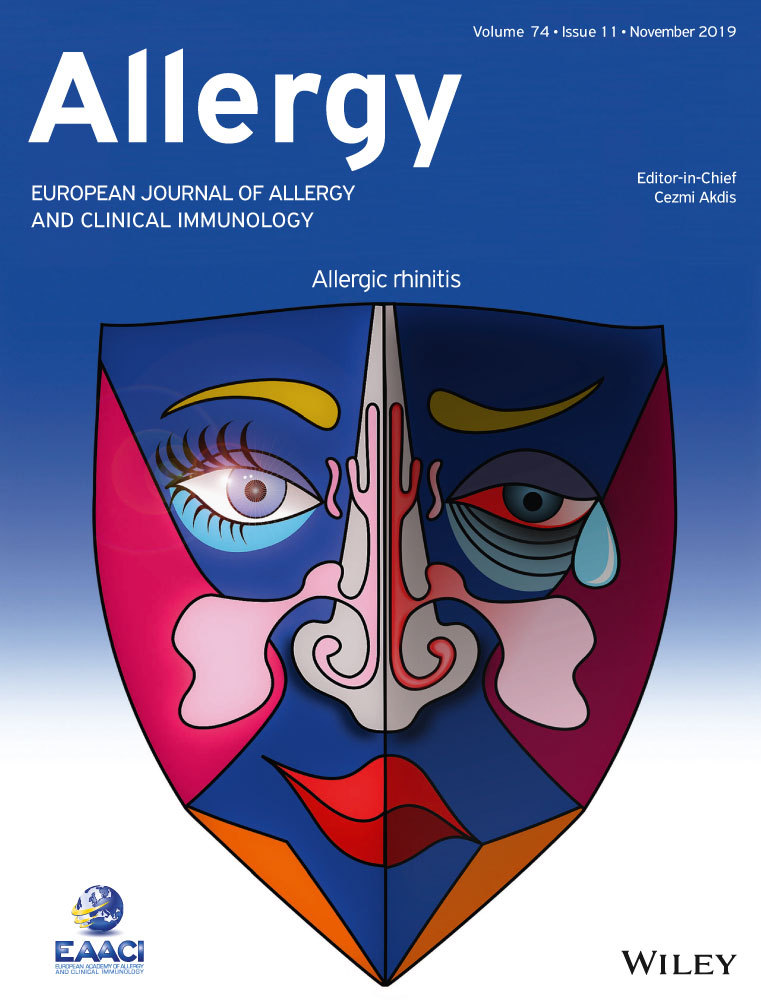Nasal peanut+ CpG immunotherapy enhances peanut-specific IFN-γ in Th2 cells and IL-10 in non-Th2 cells in mice
Brandi T. Johnson-Weaver
Department of Pathology, Duke University School of Medicine, Durham, North Carolina
Search for more papers by this authorGregory D. Sempowski
Department of Pathology, Duke University School of Medicine, Durham, North Carolina
Department of Medicine, Duke University School of Medicine, Durham, North Carolina
Duke Human Vaccine Institute, Duke University School of Medicine, Durham, North Carolina
Search for more papers by this authorCorresponding Author
Herman F. Staats
Department of Pathology, Duke University School of Medicine, Durham, North Carolina
Duke Human Vaccine Institute, Duke University School of Medicine, Durham, North Carolina
Department of Immunology, Duke University School of Medicine, Durham, North Carolina
Correspondence
Herman F. Staats, Department of Pathology, Duke University Medical Center, Durham, NC.
Email: [email protected]
Search for more papers by this authorBrandi T. Johnson-Weaver
Department of Pathology, Duke University School of Medicine, Durham, North Carolina
Search for more papers by this authorGregory D. Sempowski
Department of Pathology, Duke University School of Medicine, Durham, North Carolina
Department of Medicine, Duke University School of Medicine, Durham, North Carolina
Duke Human Vaccine Institute, Duke University School of Medicine, Durham, North Carolina
Search for more papers by this authorCorresponding Author
Herman F. Staats
Department of Pathology, Duke University School of Medicine, Durham, North Carolina
Duke Human Vaccine Institute, Duke University School of Medicine, Durham, North Carolina
Department of Immunology, Duke University School of Medicine, Durham, North Carolina
Correspondence
Herman F. Staats, Department of Pathology, Duke University Medical Center, Durham, NC.
Email: [email protected]
Search for more papers by this author
Supporting Information
| Filename | Description |
|---|---|
| all13738-sup-0001-FigS1-S4.pdfPDF document, 479.2 KB |
Please note: The publisher is not responsible for the content or functionality of any supporting information supplied by the authors. Any queries (other than missing content) should be directed to the corresponding author for the article.
REFERENCES
- 1Kulis M, Saba K, Kim EH, et al. Increased peanut-specific IgA levels in saliva correlate with food challenge outcomes after peanut sublingual immunotherapy. J Allergy Clin Immunol. 2012; 129(4): 1159-1162.
- 2Yu W, Freeland DM, Nadeau KC. Food allergy: immune mechanisms, diagnosis and immunotherapy. Nat Rev Immunol. 2016; 16(12): 751-765.
- 3Kulis M, Gorentla B, Burks AW, Zhong XP. Type B CpG oligodeoxynucleotides induce Th1 responses to peanut antigens: modulation of sensitization and utility in a truncated immunotherapy regimen in mice. Mol Nutr Food Res. 2013; 57(5): 906-915.
- 4Srivastava KD, Siefert A, Fahmy TM, Caplan MJ, Li XM, Sampson HA. Investigation of peanut oral immunotherapy with CpG/peanut nanoparticles in a murine model of peanut allergy. J Allergy Clin Immunol. 2016; 138(2): 536-543.
- 5Liang HE, Reinhardt RL, Bando JK, Sullivan BM, Ho IC, Locksley RM. Divergent expression patterns of IL-4 and IL-13 define unique functions in allergic immunity. Nat Immunol. 2011; 13(1): 58-66.
- 6Gallo E, Katzman S, Villarino AV. IL-13-producing Th1 and Th17 cells characterize adaptive responses to both self and foreign antigens. Eur J Immunol. 2012; 42(9): 2322-2328.
- 7Krawczyk CM, Shen H, Pearce EJ. Functional plasticity in memory T helper cell responses. J Immunol. 2007; 178(7): 4080-4088.
- 8O'Konek JJ, Landers JJ, Janczak KW, et al. Nanoemulsion adjuvant–driven redirection of TH2 immunity inhibits allergic reactions in murine models of peanut allergy. J Allergy Clin Immunol. 2018; 141(6): 2121-2131.
- 9Wisniewski JA, Commins SP, Agrawal R, et al. Analysis of cytokine production by peanut-reactive T cells identifies residual Th2 effectors in highly allergic children who received peanut oral immunotherapy. Clin Exp Allergy. 2015; 45(7): 1201-1213.




